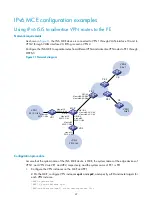
37
Configuring IPv6 MCE
Overview
In an IPv6 MPLS L3 VPN, an IPv6 MCE advertises IPv6 routing information between the VPN and the
connected PE and forwards IPv6 packets. An IPv6 MCE operates in the same way as an IPv4 MCE. For
more information, see "
Configuring an IPv6 MCE
Configuring VPN instances
By configuring VPN instances on a PE, you isolate not only VPN routes from public network routes, but
also routes of a VPN from those of another VPN. This feature allows VPN instances to be used in network
scenarios besides MPLS L3VPNs.
Creating a VPN instance
A VPN instance is associated with a site. It is a collection of the VPN membership and routing rules of its
associated site. A VPN instance does not necessarily correspond to one VPN.
A VPN instance takes effect only after you configure an RD for it.
You can configure a description for a VPN instance to record its related information, such as its
relationship with a certain VPN.
To create and configure a VPN instance:
Step Command
Remarks
1.
Enter system view.
system-view
N/A
2.
Create a VPN instance and
enter VPN instance view.
ip vpn-instance
vpn-instance-name
N/A
3.
Configure an RD for the VPN
instance.
route-distinguisher
route-distinguisher
N/A
4.
Configure a description for
the VPN instance.
description
text
Optional.
Associating a VPN instance with an interface
After configuring VPN instances, you must associate the VPN instances with the interfaces connected to
the VPN sites and the PEs.
To associate a Layer 3 aggregate interface with a VPN instance, you must associate all the member ports
of the aggregate interface with the VPN instance.
Executing the
ip binding vpn-instance
command on an interface deletes the IPv6 address of that
interface. You must reconfigure the IPv6 address of the interface after executing the command.
To associate a VPN instance with an interface:






























